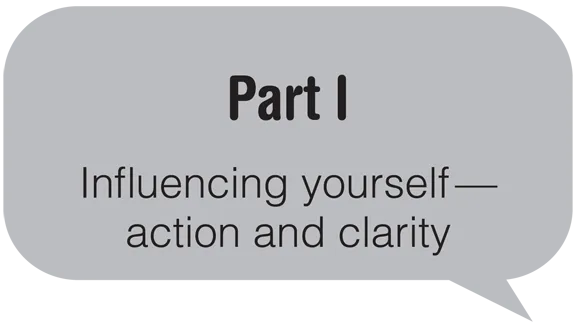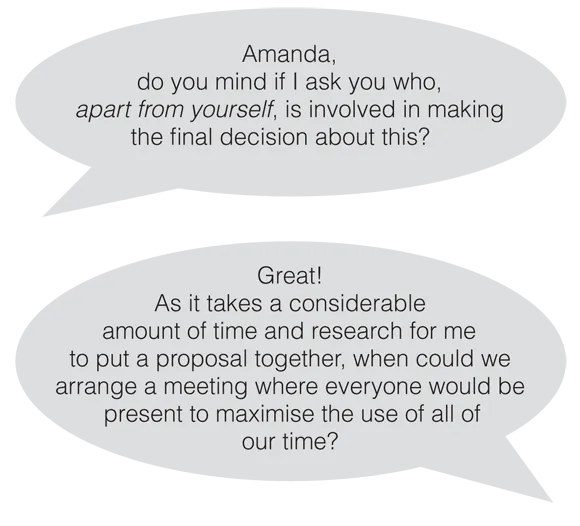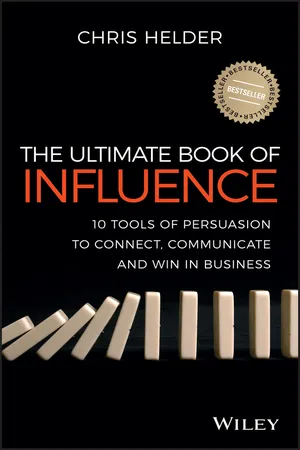The first part of this book is about influencing yourself. When I say that, it is about creating a new level of action to go achieve what it is you are after. The problem, of course, is many people do not have any idea what it is that they are after. So, this part of the book will address these two main concepts — action and clarity
Three tools will be presented in this section of the book:
Tool number 1: breaking down the e-wall
• How to avoid a game of e-pong, where the customer hides behind the e-wall.
• Strategies for creating leverage and moving that customer to taking action.
• How to create a face-to-face environment to influence the customer directly.
Tool number 2: the butterfly
• How to recognise that the number one thing that holds people back is fear.
• How to change anxiety into an action signal.
• How to use that action signal to create successful habits and new results in business and life.
Tool number 3: the sunset
• How to gain clarity about what area of your life you want greatest results in.
• Using the sunset as a tool to uncover the clarity of others.
• How to use that understanding of others to influence them.
Customers are busier than they have ever been before. The easiest way for them to decipher and consider your proposal is when it has been in writing and sent via email. In this way, they are the ones who are in the box seat, able to read and consider the proposal in their time. They are able to compare your proposal to other written proposals, shift around the priority of the proposal depending on their workload, and all of this without your being able to exert your power of influence.
This is because the digital age has created a virtual electronic wall, the e-wall, which our clients can now hide behind. The pattern of communication has become less about face-to-face interaction, and it is acceptable to do business via email.
The e-pong timeline
This is a typical interaction for a proposal that is emailed in the new reality. It is a game that I call e-pong! You have researched, found your decision maker and sharpened your angle to win the business.
• You make a call. The decision maker is pleased to hear from you, but he or she is busy. They ask you to put your proposal in writing and send it to them for review, via email (one week).
• You send your proposal via email.
• The decision maker responds that he or she has received your proposal and will review in due course and respond via email (two weeks).
• You follow up via email in a couple of weeks after hearing nothing back (four weeks).
• Your decision maker is busy and distracted by the day-to-day running of a business. They take four days to respond to your email and say that they are apologetic but will get back to you shortly with a decision after they chat to the relevant people via email (five weeks).
• Based on the reply, you are inclined to give the decision maker another week before hassling them again via email for an answer.
• You send another email to your decision maker asking if a decision has been made (six weeks).
• Nothing is heard back, and doubts creep in about the priority your proposal is being given.
• You write via email one last time stating that you are just wrapping up the quarter or ticking things off your task list and asking once more whether any decision has been made (seven weeks).
• You receive an answer via email four days later from your decision maker, thanking you for the hard work you put into the proposal, but unfortunately other priorities have arisen in the company and they are unable to proceed with the business at this time (eight weeks).
Eight weeks of e-pong, with no result. This has all happened because you let the decision maker hide behind their e-wall. In fact, this happened because you also hid behind the e-wall! It takes courage to break down the wall and be in a position to influence that customer face to face.
It is simply easier to have an email relationship with someone. It is easier to send your client a monthly update or a quarterly newsletter and consider that the job is done. Most of all, it is certainly easier to try to win a sale by sending the client a proposal and play e-pong. It is much harder to pick up the phone and get face to face with our clients to cut through all of the procrastination and time wasting.
Don’t get me wrong. There are times that email is the only option. I realise that. All I am trying to do is challenge you to think about how you can create more face-to-face interactions. What can you do to break down the e-wall?
Changing timelines
Let’s take sales, for example. Salespeople talk to me all the time about the difficulty in getting face to face with their clients so they can utilise their skills of influence. They discuss changing trends in technology and adapting to the way business is done. However, the timeline of a sale has barely changed in terms of basic action plan connect points, but the underlying message consistently flowing through is that the amount of time between first contact and closing has significantly increased.
Why has this happened?
It would be easy for salespeople to stand fast, and claim that the e-wall is just another excuse or a trend, and that if you believe in your being personable and having sound communication skills, then nothing should stop you or delay your sales process. My personal favourite excuse dished out by your average motivational speaker is: ‘If it’s not working, then you must be doing it wrong!’ To my way of thinking, this is less than helpful advice, and certainly does not recognise the changing way that business is being conducted in the 21st century. You cannot deny the advances in technology. The statistics tell us that we are more likely to communicate by email or social media than to pick up the phone or meet face to face. We are nearly all capable of conducting business in a completely mobile environment and we are more contactable than ever with our portable devices and Wi-Fi technology, and yet to close a sale is taking longer than ever before.
Five strategies to break down the e-wall
Here are five strategies you can use to help break down the e-wall and stop playing so much e-pong.
1 Identify the decision makers
At some point, usually before you have the opportunity to meet face to face with the client or send them a proposal, you will have spoken to the client on the telephone to set up everything. One of the biggest mistakes that I see people make is that they send through information without knowing exactly who all the decision makers are. They know the person that they are dealing with, however they have not asked the question in terms of who will really be making the call.
Now, I know what some of you are thinking: ‘Chris, it doesn’t work that way in my business! We can’t always get to the decision maker right away.’ Okay, fair enough. This book is throwing a whole bunch of spaghetti (ideas) at the refrigerator door. If it sticks, take it. If not, let it fall to the floor. However, in your business, I want you to be clear that the person you are presenting to is definitely the person who can get you to the next level of your sale.
It happens all the time that people speak to a non-decision maker simply because it was easier to send them through the information. Often, you were directed to this person as a gatekeeper. You are spending hours putting together a proposal for your business and this non-decision maker is encouraging you to send it through to them where it really has no chance of getting off the ground.
If you want to make sure that you know who all the decision makers are, here is the gold. I’ve tried this question a lot of different ways and this is the way that will give you the best chance to get this information.
As simple as that is, so many people ask it the wrong way. I hear people say things like, ‘Do you mind me asking: are you the decision maker with this?’
This is so close, but it leaves a lot of loopholes because it is so easy for the non–decision maker to say, ‘Yes, I am the decision maker.’ Then, after you spend two hours putting a proposal together for them, they tell you that they have to run it by the boss or by the HR department. You’ve wasted your time!
The reasons that they say ‘Yes, I am the decision maker’ may just be that they are one of the decision makers, and they may not want to bother the boss until they have all the information. It could be that they are putting you off. It may simply be a case of ego. However, when you use the words ‘apart from yourself’, they realise the importance of not wasting everyone’s time and it also flatters their ego. By the way, if they won’t have the meeting with all of the decision makers present, you may have just realised that you were going to be put off anyway!
By using these simple words you have increased your ability to know who will be involved in making the final decision. Give this a try and increase the impact of your time and effectiveness.
2 Dictate the best method of communication
It happens all the time that a client will simply say, ‘Email your proposal through and we will have a look at it.’ It is easy for everyone. The first part of the game of e-pong is underway. The question I would ask you is how often does your client dictate how the communication will work through the pitch and decision process? Do you let your client tell you what the best way to contact them is? Can you dictate how it should work?
Ask yourself these three questions:
• What is their preferred method of communication?
• Is that going to be the best form of communication to get your proposal approved?
• What is your strategy to create an environment where you can communicate in the best possible way to get that proposal approved?
Remember, there are times when you are going to have to email the proposal through because that is the method of communication that the client requires. How...






